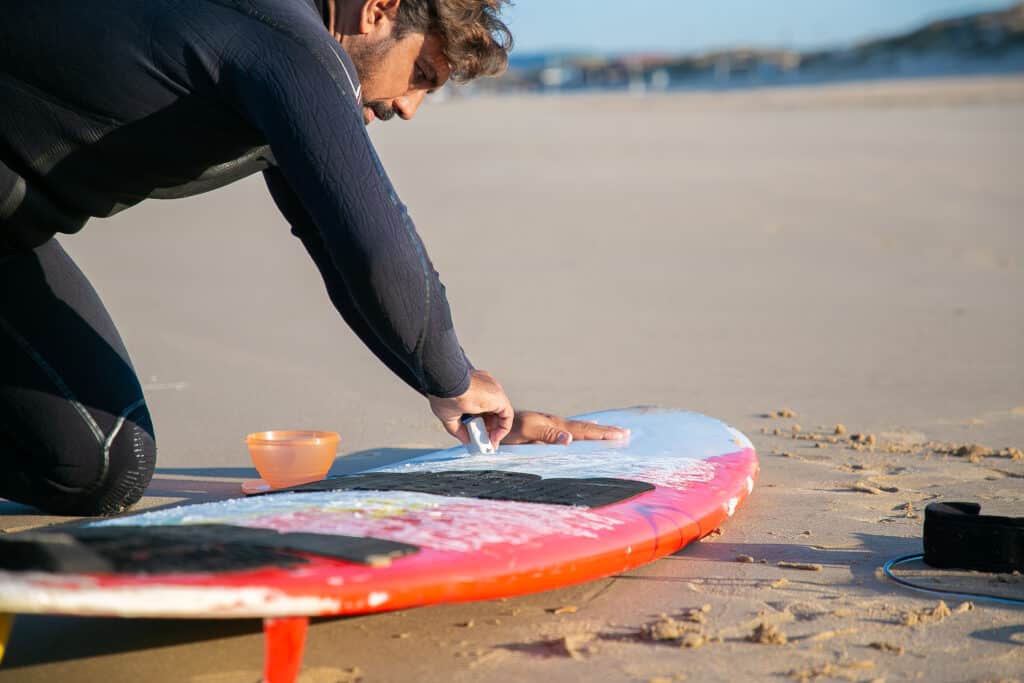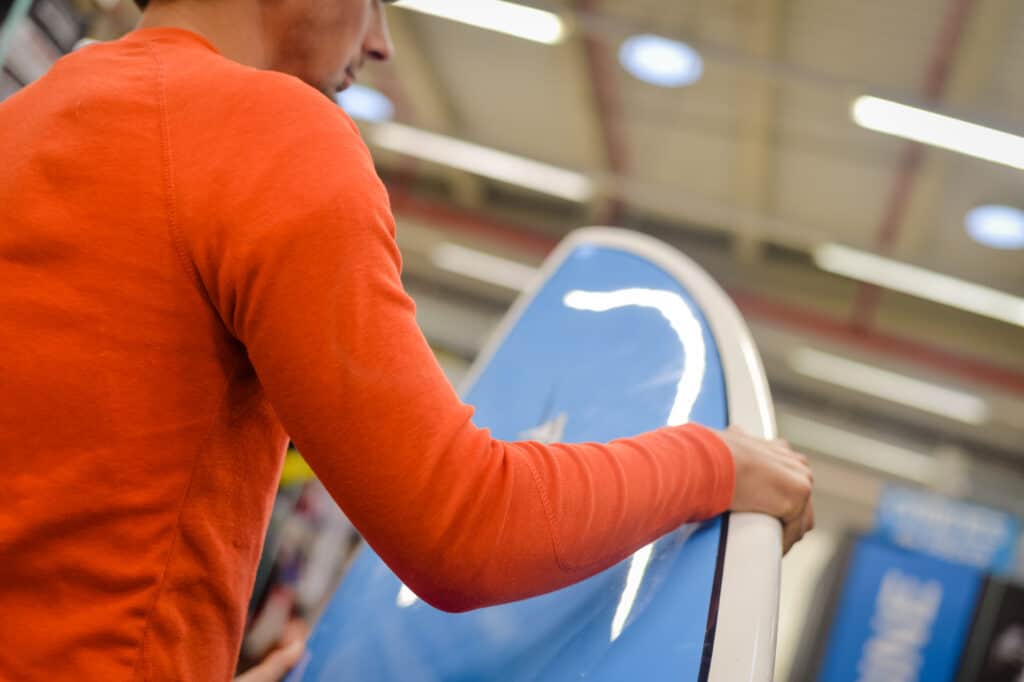
Surfboards come in many different sizes and shapes for different feels and purposes. Due to the high price, purchasing a brand new board is difficult whenever you want to try a different one. Unlike a car, there aren’t many places to try a surfboard. Even if you can try, it’s difficult to find the exact size of the board you are after.
This is when purchasing used surfboards are useful. Like cars, a surfboard tends to lose value quickly as soon as you buy it. If you know where and how to purchase a good value secondhand board, you can get a decent surfboard potentially close to half the price.
So here are some tips on how to look for and buy a good second-hand surfboard.
How much should I pay for a used surfboard?
Generally, a secondhand shortboard in good condition, without major damage/ding, should cost around 300-550+ whereas secondhand longboard costs around 400-700+. Just like cars, brand, age and quality of the surfboards determine the price.
If you are interested in a specific brand and model, you can find the price estimation by searching previously sold items on eBay or Gumtree. You can see the general quality of the board by checking the photo and then matching it with the price. Once you check 3-4 boards of the same kind, you can get a rough estimation of a certain surfboard.
For shortboards, brands like Al Merrick, JS, Lost, Pyzel, Hayden shapes and Firewire are well recognised worldwide and generally pricier than generic surfboard brands. However, well-established local brands will also have a higher price tag depending on where you live. For example, some medium-sized surfboard manufacturers in Sydney, such as Chilli surfboards, retain good resale value.
Longboards are more expensive than shortboards, and the price range tends to be wider for longboards. Reputable brands like Walden, Mctavish, Vouch, Bear and Firewire retain the resale value well.
The price also depends on whether the seller includes a bag, fins and leash. All 3 together may add extra 50-100 dollars depending on the quality of the product.
Where should I Buy a used board?
- Surfshop. This is an easy option but usually has limited stocks; some shops would have less than 10 secondhand boards while others have 100+. When you buy a secondhand board at the shop, expect to pay some premium.
- Buying directly from a person/seller: Face to Face. This is the most usual form of buying a second-hand surfboard. You may use different online platforms such as eBay, Gumtree, Facebook Market place or Craigslist.
- Searching Tip: when searching for a surfboard to purchase, try searching everything under the categories rather than putting a certain brand or name of the surfboard. This way, you can capture all of the listed and may score some bargains.
What Should I Check Before Buying a second-hand board?
When purchasing a second-hand board, you will need to check dings/cracks throughout the board, soft spots in glassing, the colour of the board, the shape of the board near the stringer, cracks near fin boxes and signs of the previous repair.
Let’s explore each point in more detail.

Dings/Cracks Of The Glassing
Ding refers to the damage to the surfboard glassing. It is an inevitable part of surfing regardless of how careful you are. When inspecting dings, you must figure out whether the ding is still water-tight.
Pressure dings and spider web cracks are generally considered ok. Pressure dings are from a surfer’s toes and heels during the turn. Unless excessive, these are acceptable. If you want to be sure, ask the seller to remove the wax before you arrive so you can check the board’s deck.
Some minor dings are difficult to see at night even if you use good phone light. So always inspect the board during the daytime if you can.
When you find dings that look open – can visually see the foam through them, you would want to know if water has gone inside. Ask the seller if he has surfed it with the ding on it, and you can also check by pushing the finger in gently to see if your finger comes with moisture.
Soft Spots / Bubble On The Glassing
If the board absorb the water, it can cause delamination; separation of the glassing from the foam. You can tell by gently pushing with your fingers on the glass. It is usually quite obvious and often makes little crunching noise.
A bubble under the glassing can form when the water inside the foam tries to evaporate and gets trapped under the glassing.
If you want to repair soft spots or bubbles, you must remove all the floating glassing and get new fibreglass. Depending on the size of the area, the repair may cost you more than the cost of the board.
So, make sure you feel the board entirely, especially around its rail, tail and fin boxes, before purchasing.
Colour Of The Board
New surfboards are white and change their colour to brownish-yellow as they get exposed to the sun(UV). Therefore, you can half guess the age of the board by looking at its colour. However, many surfboards have coloured glassing, making it difficult to guess their age.
Also, when you purchase a colour surfboard, beware of the previous repair signs. I purchased a longboard once without knowing it was snapped in half. I only found out when my friend pointed out subtle discontinuity of the colour, which indicates the board has been repaired with paint to match the previous graphic.

Shape Of The Foam Near The Stringer
Over time, the foam tends to shrink, and the stringer does not. Stringer is made of timber and does not change its shape over time. Therefore, by checking around the stringer, you can tell if the board is aged. However, this only happens when the board is significantly old.
Cracks Near the Fin Box
Cracks near the fin box/plugs can be very subtle, and if you miss them, it may cost quite a bit to repair. When the surfboard gets used and ridden, some movement will be near the fin box as the fins provide a pivoting point. Also, when you handle and store the surfboards, the fins can get caught, which may cause micro damage where it has been attached.
When these are damaged, it’s quite difficult to repair compared to repairing the deck, rail or nose. More often than not, you will have to ask the professionals to repair it, which may cost around 100 dollars.
Ensure you feel the glassing with your fingers and look carefully with good light. If in doubt, either drop the deal or ask the seller to give you a discount on the amount to repair the board.
Previous Repair
A surfboard is fragile and previous repairs of a surfboard are very common. This should not affect the board if done professionally or properly. To check if the job has been done properly, simply run your fingers on the repairs and see if the repaired sections are well levelled and smooth compared to their surroundings. Ultimately it’s up to you to be ok with the previous repair. Go with your heart.
However, some sellers repair buckled (bent), snapped boards and use painting/graphics to cover the repair. Unfortunately, a very small minority of people will not disclose this history, and it’s your job to make sure you don’t miss this. Fortunately, it is very difficult to completely hide the repair, and it will show a slight mismatch in colour/graphics if you look carefully enough.
Avoid buying a surfboard that has been snapped or buckled in the past. The strength and characteristics of the board won’t be the same, even with professional repairs. Like any sport, confidence/psychology matters when you surf, and I found it difficult to trust a board that has significant damage in the past.
Another tip is to be careful when buying a secondhand surfboard with colourful stripes across the board. There are beautiful to look at, but it’s quite easy to hide a snapped/buckled part.
Volume
One thing beginners often forget to check is the volume of the surfboards. Volume is one of the most important factors of the board, and all modern boards come with the volume written with the dimension of the board. The volume will determine the padding power; you do not want to reduce it drastically as you may struggle to catch waves.
Negotiation tips for buying a secondhand surfboard
Here are a few tips on how to negotiate with the seller.
- Know your price. Check previous sales history from eBay or Gumtree and have a rough board estimation before your inspection.
- Check the board thoroughly. Nothing is worse than realising you had purchased a significantly damaged board without knowing it would cost 300 dollars to fix it.
- Negotiate before you inspect. If you are timid, negotiating the price face to face can be quite uncomfortable. I found it much easier to call the price before I inspect the board. There are no surprises, and you can avoid unnecessary tension.
- Make the seller inspect the board thoroughly before you meet them. Ask them to check the specific areas of the board for dings around the fin box/plugs and tail. If he finds any dings, you might get more discount or walk away if you don’t buy the damaged board.
- Ready to walk away! Make sure you communicate with the seller that you are only looking first and if it does not feel right, politely refuse and walk away. If you are not screaming “HELL YEAH!” for the deal, it may not be the right board for you.
You might be thinking, why do I have to go through all these to buy a second-hand board while I can afford a new one? Fair enough. There are pros and cons to buying a second-hand surfboard. Let’s compare
Secondhand vs Brand New Surfboard
Why buy a Second-Hand surfboard?
- Environment and sustainability. Unfortunately, most discarded surfboards go to landfills. EPS form is known to be recyclable, but I couldn’t find a place to recycle the board. Therefore, it’s important to make the most of the board as long as possible. Buying, selling, repairing and giving away secondhand surfboards is the best way to reduce the landfills.
- Beginner surfers are not used to handling the board in or out of the water, which will cause a ding. Therefore beginner surfers should consider purchasing a secondhand surfboard as a first surfboard.
- Cheaper. Generally, good-condition second-hand surfboards sell for around 40-60 per cent of their original value, depending on the brand.
- Good Re-sale value. Not only it’s cheap to buy, but you can also sell it at a very similar price after riding for a year or so if you look after it well. This is a fantastic advantage for beginners as they will usually progress to a smaller board with improved skills.
- You can abuse it a little. Your brand new shiny board will get a ding, and you will treat it like a second-hand board.
- Meet other surfers while when buying a board. When the deal goes well, and both sides walk away feeling it was fair, it gives you extra enjoyment: this feeling may last a very long time.
- Get to try many different types of boards. Surfers love to try different boards. With a reduced price, you can almost buy two good condition boards for the price of a new board. It will help you fine-tune the board’s volume, especially for beginners.
Why Buy a New Board?
- You can trust your board to be in perfect condition. Even if you check the secondhand board to the best ability, you may miss the small dings or previous damage. Buying a new board gets rid of this issue.
- Board is more lively. Experience surfers can feel the board twist and recoil during the turn; this property of the board will diminish over time as the board age.
- Nothing beats the new board with new wax! It’s a personal opinion; It feels great to own a beautifully crafted surfboard and put a new wax on it! It’s like getting a new car. Financially does not make sense, but it sure feels amazing.
- You will be forced to learn how to handle the board proper way and protect the board for its longevity.
- Experienced surfers have already tried many types of boards and are well aware of their preferences. Therefore, they would go for a brand new board, knowing exactly what they are after.
I strongly recommend purchasing a secondhand surfboard for beginner surfers until they know your surfboard well and what types of surfing they are after. Hope you find your dream board soon and get stoked!


I do not even understand how I stopped up right here,
however I believed this post used to be good. I do not realize who you might be but definitely you
are going to a famous blogger if you are not already.
Cheers!
Thank you
Hey there, I think your site might be having browser compatibility issues.
When I look at your website in Opera, it looks fine but when opening in Internet Explorer,
it has some overlapping. I just wanted to give you a quick
heads up! Other then that, fantastic blog!
Thank you, I will look into it
First of all I want to say superb blog! I had a quick question that I’d like to ask if you do not mind. I was interested to find out how you center yourself and clear your mind before writing. I have had a hard time clearing my mind in getting my ideas out. I do enjoy writing but it just seems like the first 10 to 15 minutes are generally wasted simply just trying to figure out how to begin. Any suggestions or hints? Many thanks!
I honestly struggle with the same. Maybe it’s normal haha
Discuss the importance of environmental values and how they shape attitudes toward sustainability, conservation, and ecological responsibility.
Great idea. Thank you